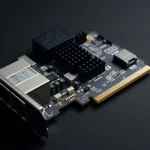Easy file sharing between PCs using your Wi-Fi router trick

Sharing files between computers has never been easier, especially with the functionality built into modern Wi-Fi routers. By utilizing the USB ports available on your router, you can create a shared drive accessible to all devices on your network. This article will guide you through the process step by step, ensuring you can transfer files seamlessly within your home or office.
Creating a shared drive through your router is a convenient method to access files from multiple devices. Here’s how you can set it up:
- First, choose a USB flash drive or external hard drive and connect it to the USB port located at the back of your router. This drive will serve as your shared storage.
- Next, on your computer, open a web browser and enter your router's IP address in the address bar. You will need to log in using the router's admin credentials to access the settings screen.
- Once inside the settings, navigate to the section labeled “drive storage” or “file sharing.” Here, you should see your connected drive appear on the screen. If your router allows, create a shared folder that will further organize your files.
- If your router does not support this option directly, you can set up a shared folder using Windows. Open File Explorer, select “Network,” and type your router’s IP address in the format \routerip (e.g., \192.168.1.1), then press Enter.
- Your external drive should now be visible in File Explorer as a shared drive. To make access easier, consider creating a shortcut to the drive on your desktop.
To access the shared drive from other computers within your network, you’ll need to map the drive. Here’s a straightforward way to do this:
- Open File Explorer by double-clicking its icon or by pressing Windows Key + E. In the left-hand navigation pane, select This PC.
- Click on the three-dot menu in the command bar at the top and select Map network drive….
- From the drop-down list, select a drive letter that will represent your shared drive. Enter the network path for the shared folder, which should look something like \192.168.1.1sharedfiles.
- To ensure the drive connects automatically in the future, check the Reconnect at sign-in box before clicking Finish.
After successfully mapping the drive, you will be able to access it on that computer as if it were a local drive. However, keep in mind that this drive is open to anyone on your network, so avoid storing sensitive information.
Utilizing a shared drive offers numerous advantages, especially in a collaborative environment:
- Centralized Storage: All files are stored in one location, making it easier to manage and access them.
- Simplified Collaboration: Multiple users can access and modify files simultaneously, enhancing teamwork.
- Easy Backup: Regularly backing up the shared drive can protect important data from loss.
- Cost-Effective: Instead of purchasing additional cloud storage solutions, you can use your existing router for file sharing.
Alternative Methods for File Transfer Between PCs
If you prefer not to use a shared drive via your router, there are other methods available for transferring files between computers:
- Direct Wi-Fi Transfer: Software like FShare allows for easy file transfers over Wi-Fi.
- File Transfer Protocol (FTP): Setting up an FTP server can provide a reliable way to transfer large files securely between computers.
- Third-Party Applications: Programs such as Send Anywhere or ShareIt can facilitate file sharing across different platforms.
Using Wi-Fi Direct for File Sharing
Wi-Fi Direct is another effective method for file sharing that allows two devices to connect directly without needing a router. Here’s how to set it up:
- Ensure that both devices support Wi-Fi Direct.
- On one device, enable Wi-Fi Direct and wait for it to search for available devices.
- Select the other device from the list and establish a connection.
- Once connected, use the file transfer options displayed to send files directly between the devices.
Streamlining Your File Sharing Experience
For a more efficient file-sharing experience, consider the following tips:
- Organize Your Files: Keep files in clearly labeled folders to easily locate what you need.
- Regularly Review Access Permissions: Ensure that only authorized users have access to sensitive folders.
- Utilize Automation: Set up automatic backups to safeguard your shared drive contents.
For visual learners, the following video tutorial explains the process of transferring files wirelessly between PCs using a Wi-Fi router:
By following these steps, you can take full advantage of your Wi-Fi router's capabilities to streamline your file-sharing process. Embrace the convenience of modern technology to enhance your productivity and collaboration!




Leave a Reply